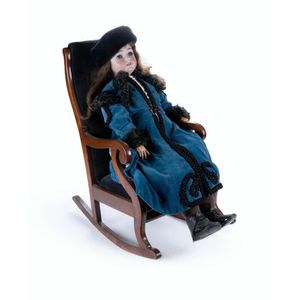Antique German Bisque Doll with Rocking Chair
Simon & Halbig large child bisque doll. German, c.1910, impressed 10 Simon & Halbig SH16, blue eyes with mohair lashes, open mouth, pierced ears, brunette human hair wig and pate, composition and wood ball jointed body, very slight chips to pierced ears, little finger is missing from left hand, right toes are slightly chipped, sole of left foot on this doll is cracked and repaired, well dressed in cotton underwear, cotton dress with pin tuck detail, cobalt blue velvet coat, label to foot 'Hand made by Irene Stroud Wsm,' lined in violet brocade, trimmed in black mohair with antique fastening, black pill box hat. Doll comes with her well-made bentwood child's rocking chair, upholstered in dark blue velvet. Height 92 cm
You must be a subscriber, and be logged in to view price and dealer details.
Subscribe Now to view actual auction price for this item
When you subscribe, you have the option of setting the currency in which to display prices to $Au, $US, $NZ or Stg.
This item has been sold, and the description, image and price are for reference purposes only.
- Composition - Composition is a material used for dolls, sculpture and furniture. It is a type of composite material made from a mixture of materials such as sawdust, glue, and pigments. It is a popular material for dolls and figurines because it is lightweight and easy to work with. It is also used in furniture-making, particularly in the construction of decorative pieces such as figurines and sculptures. It is less common in high-end furniture as it is not as durable as some other materials such as wood or metal. However, it is a more affordable and accessible option for some types of decorative pieces.
- Pate - The pate in a doll is a rounded piece of either cork or papier mache that covers the wig aperture of a doll, (the opening in the crown of the doll) and provides the base to which the wig can be attached.
- Mohair - Mohair is a type of fabric or yarn that is made from the hair of the Angora goat. Mohair is known for its softness, luster, and durability, and it is often used in high-end fashion and textile products.
The Angora goat is native to Turkey, but it is now raised in many parts of the world, including South Africa, the United States, and Australia. The goats are sheared twice a year to harvest their long, silky hair, which can be up to 30 cm (12 inches) in length.
The hair is then spun into yarn, which can be woven or knitted into fabrics for clothing, blankets, and other textiles. Mohair is often blended with other fibers, such as wool or silk, to improve its strength and texture.
Mohair is prized for its softness, which comes from the fine, tightly curled fibers of the Angora goat's hair. The fibre is also naturally lustrous, with a shiny, almost metallic appearance. Mohair is also highly durable and resistant to moisture, making it a popular choice for high-end fashion products such as suits, coats, and evening wear. - Open Mouth Doll - An "open mouth" doll is a doll with a mouth that is designed to be open showing moulded or inserted teeth, as if the doll is in the process of speaking or singing. This type of doll was first introduced in the late 19th century and became increasingly popular in the early 20th century. Open mouth dolls were typically made of bisque, a type of unglazed porcelain that is fired at a lower temperature than traditional porcelain. The open mouth design allowed doll manufacturers to create dolls with a more expressive, lifelike appearance, as the open mouth made it possible to add teeth, a tongue, and other features that added to the doll's realism. Open mouth dolls were often dressed in elaborate costumes and accessories, and were marketed to both children and adults as decorative objects.
This item has been included into following indexes:
